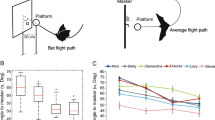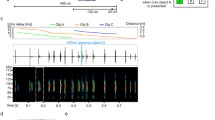Summary
-
1.
Using a discrimination task, we studied the detection of stationary and moving targets in the presence of background clutter by trainedEptesicus fuscus (Figs. 1, 2).
-
2.
During the test, the amplitude of the target echo was always larger than that of the background echoes at the bat-to-target distance of 30, 50 and 80 cm. At the bat-to-target distance of 110cm, the target echo and background echoes had about the same amplitude (Fig. 3).
-
3.
An electric motor was used to oscillate a target. The frequency content of the motor noise was mostly below 3 kHz (Fig. 4).
-
4.
Monaural ear-plugging reduced the auditory sensitivity of a bat by an average of 33.6 ±11.2 dB over its most sensitive frequency range which is between 15 and 50kHz (Fig. 5). It also reduced a bat's detection of a target (Figs. 6, 8).
-
5.
The detection of stationary and moving targets decreased with increasing bat-to-target distance (Figs. 6–8). However, a bat rejected clutter interference for a moving target more successfully than for a stationary one even when one of its ears was plugged (Figs. 7, 8).
Similar content being viewed by others
References
Ajrapetianz ESh, Konstantinov AI (1974) Echolocation in nature. Nauka, Leningrad. English Translation, Joint Publications Research Service, No. 63328, 1000 Globe Road, Arlington, Virginia 22201
Bradbury J (1968) Mechanisms of target discrimination by the echolocating bat,Vampyrum spectrum. PhD dissertation, The Rockefeller University, New York
Dijkgraaf S (1957) Sinnesphysiologische Beobachtungen an Fledermäusen. Acta Physiol Pharmacol Neerl 6:675–684
Flieger E, Schnitzler H-U (1973) Ortungsleistungen der FledermausRhinolophus ferrumequinum bei ein- und beidseitiger Ohrverstopfung. J Comp Physiol 82:93–102
Goldman LJ, Henson OW (1977) Prey recognition and selection by the constant frequency bat,Pteronotus p. parnellii. Behav Ecol Sociobiol 2:411–419
Griffin DR (1958) Listening in the dark. Yale University Press, New Haven Connecticut, 413 pp. (1958) (Reprinted by Dover Publications, New York, 1974)
Griffin DR, Galambos R (1941) The sensory basis of obstacle avoidance by flying bats. J Exp Zool 86:481–506
Griffin DR, McCue JJG, Grinnell AD (1963) Resistance of bats to jamming. J Exp Zool 152:229–250
Griffin DR, Friend JH, Webster FA (1965) Target discrimination by the echolocation of bats. J Exp Zool 158:155–168
Grinnell AD (1963) The neurophysiology of audition in bats: intensity and frequency parameters. J Physiol (Lond) 167:38–66
Grinnell AD, Griffin DR (1958) The sensitivity of echolocation in bats. Biol Bull 114:10–22
Gustafson Y, Schnitzler H-U (1979) Echolocation and obstacle avoidance in the hipposiderid batAsellia tridens. J Comp Physiol 131:161–167
Jen PH-S (1982) Echolocation in the bat: obstacle avoidance by the bat and signal coding in the bat's cerebellum. Proc Nat Sci Counc (China) 6:71–80
Jen PH-S, Kamada T (1982) Analysis of orientation signals emitted by the CF-FM bat,Pteronotus parnellii parnellii and the FM bat,Eptesicus fuscus during avoidance of moving and stationary obstacles. J Comp Physiol 148:389–398
Jen PH-S, McCarty JK (1978) Bats avoid moving objects more successfully than stationary ones. Nature 275:743–744
Jen PH-S, Schlegel PS (1982) Auditory physiological properties of the neurones in the inferior colliculus of the big brown bat,Eptesicus fuscus. J Comp Physiol 147:351–363
Jen PH-S, Lee YH, Weider RK (1980a) The avoidance of stationary and moving obstacles by little brown bats,Myotis lucifugus. In: Busnel RG, Fish JF (eds) Animal sonar systems. Plenum Press, New York London, pp 917–919
Jen PH-S, McCarty JK, Lee YH (1980b) The avoidance of obstacles by little brown bats,Myotis lucifugus. In: Wilson DE, Gardner AL (eds) International bat res conf. Texas Technical University Press, Lubbock, Texas, pp 23–28
Kick S (1982) Target-detection by the echolocating bat,Eptesicus fuscus. J Comp Physiol 145:431–435
Novick A (1965) Echolocation of flying insects by the bat,Chilonycteris psilotis. Biol Bull 128:297–314
Peff TC, Simmons JA (1972) Horizontal-angle resolution by echolocating bats. J Acoust Soc Am 51:2063–2065
Simmons JA (1968) Depth perception by sonar in the bat,Eptesicus fuscus. PhD dissertation, Princeton Univ
Simmons JA (1981) Detection of range motion in bat sonar. J Acoust Soc Am [Supp1 1] 69: S112
Simmons JA, Vernon JA (1971) Echolocation discrimination of targets by the batEptesicus fuscus. J Exp Zool 176:315–328
Suthers RA (1965) Acoustic orientation by fish-catching bats. J Exp Zool 158:319–348
Webster FA, Brazier OG (1968) Experimental studies on echolocation mechanisms in bats. T.D.R. No. AMRL-TR-67-192, Aerospace Medical Div., U.S.A.F. Systems Command
Author information
Authors and Affiliations
Rights and permissions
About this article
Cite this article
McCarty, J.K., Jen, P.H.S. Bats reject clutter interference for moving targets more successfully than for stationary ones. J. Comp. Physiol. 152, 447–454 (1983). https://doi.org/10.1007/BF00606434
Accepted:
Issue Date:
DOI: https://doi.org/10.1007/BF00606434




